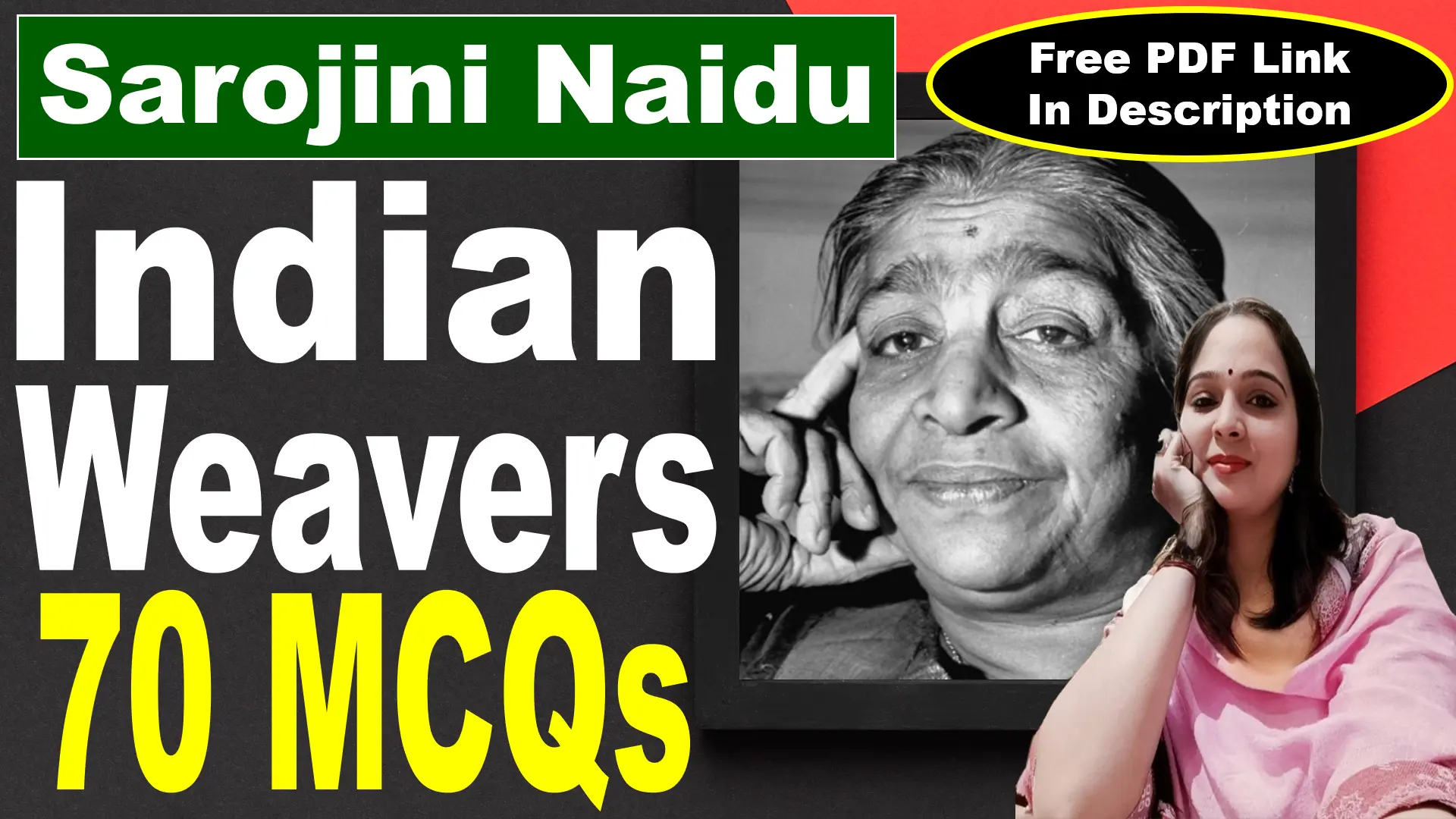
Essay Type Questions
Q. Write the critical appreciation of the Indian Weavers Poem?
Introduction: “Indian Weavers” is a beautiful poem written by Sarojini Naidu, a renowned Indian poet and political rights activist. The poem is a tribute to the weavers of India, capturing the essence of their life and work.
Theme: The central theme of the poem is the cycle of life and death, symbolized through the weavers’ craft. Each stanza of the poem represents a different stage of life – morning symbolizes birth, evening symbolizes youth or adulthood, and night symbolizes death.
Imagery and Symbolism: Naidu uses vivid imagery and symbolism to bring the poem to life. The weavers’ loom is a metaphor for the cycle of life and death. The garments they weave – a blue garment for a newborn, a wedding veil for a bride, and a white shroud for the dead – symbolize the different stages of life.
Language and Style: Naidu’s language is simple yet evocative. She uses repetition to emphasize the monotony of the weavers’ work and the inevitability of the life cycle. The poem’s rhythm mimics the rhythmic sound of the loom, further enhancing its imagery.
Rhyme and Rhythm: The poem follows a regular rhyme scheme (aabb, ccdd, eeff), which adds a musical quality to it. The rhythm of the poem, like the rhythm of the weavers’ loom, is steady and unchanging, reflecting the unchanging cycle of life and death.
Tone: The tone of the poem is both celebratory and somber. Naidu celebrates the skill and craftsmanship of the Indian weavers, but also acknowledges the somber reality of life’s transience.
Conclusion: In conclusion, “Indian Weavers” is a poignant poem that beautifully captures the essence of Indian culture and tradition. Through her vivid imagery and symbolic language, Naidu paints a moving picture of the weavers’ life, their craft, and the universal cycle of life and death.
Q. Discuss the poem “indian weavers” by sarojini naidu in light of its themes, imagery, and poetic devices.
Sarojini Naidu’s poem “Indian Weavers” explores the cyclical nature of life, the weavers’ craft and artistry, and the contrast between joy and sorrow. The poem uses vivid imagery and poetic devices such as repetition, simile, metaphor, symbolism, and contrast to create a short yet profound exploration of the human experience.
Themes
Life’s cycle: The poem portrays the different stages of life through the garments woven by the weavers: the joyous birth of a child, the celebratory moment of a queen’s wedding, and the solemnity of death. The weavers symbolize the threads of life’s tapestry, reflecting the cycle of existence from beginnings to endings.
Art and craftsmanship: The poem celebrates the weavers’ skill and artistry, depicting them as master craftsmen who can weave garments with the vivid colors and delicacy of peacock plumes or the purity of a cloud. Their craftsmanship is both practical and artistic, creating beautiful garments that meet practical needs.
Contrast: A significant theme in the poem is the contrast between the colorful and joyous aspects of life (birth and marriage) and the somber and solemn (death). The weavers play a role in all these moments, emphasizing the dualities and contradictions of human experience.
Imagery
Colors: The poem is rich in colorful imagery, describing garments as being “blue as the wing of a halcyon wild” and “purple and green like the plumes of a peacock.” These vivid descriptions paint a vibrant picture of the weavers’ creations.
Nature: The poem uses nature-related imagery, such as “feather,” “cloud,” and “halcyon wild,” to evoke a sense of beauty and purity in the garments woven by the weavers.
Time of Day: The poem uses the time of day, such as “break of day” and “fall of night,” to create a sense of time passing and to connect the weavers’ work to different moments in life.
Poetic Devices
Repetition: The poem employs the repetition of the question, “Why do you weave a garment so…?” to structure the stanzas and highlight the contrast in the weavers’ creations.
Simile: The poem uses similes to draw comparisons between the garments and elements of nature, as in “blue as the wing of a halcyon wild.”
Metaphor: The weavers are metaphorically portrayed as the creators of life’s fabric, weaving the “robes of a new-born child” and a “dead man’s funeral shroud.”
Symbolism: The weavers symbolize the weavers of destiny, shaping and weaving the events and milestones of life.
Contrast: The poem effectively employs contrast as a literary device. It contrasts the brightness and colors of life’s joyous moments with the white solemnity of death. This contrast emphasizes the diversity and complexity of human experience.
In conclusion, Sarojini Naidu’s “Indian Weavers” is a beautifully crafted poem that explores the cyclical nature of life, the weavers’ craft and artistry, and the contrast between joy and sorrow in human existence. The poem’s rich imagery and thoughtful use of poetic devices make it a captivating and thought-provoking piece.





